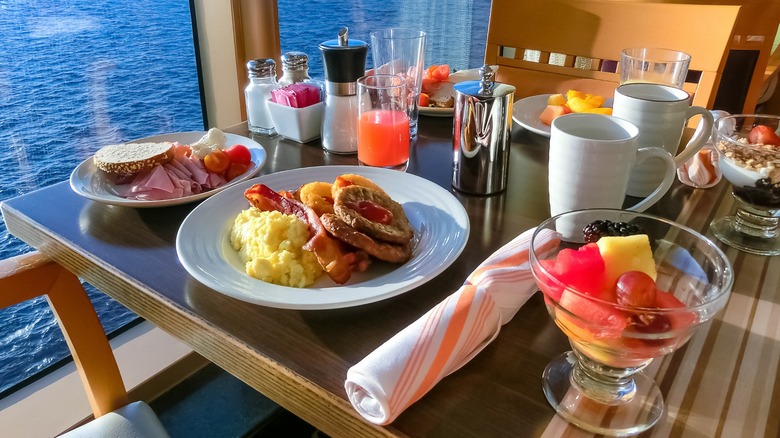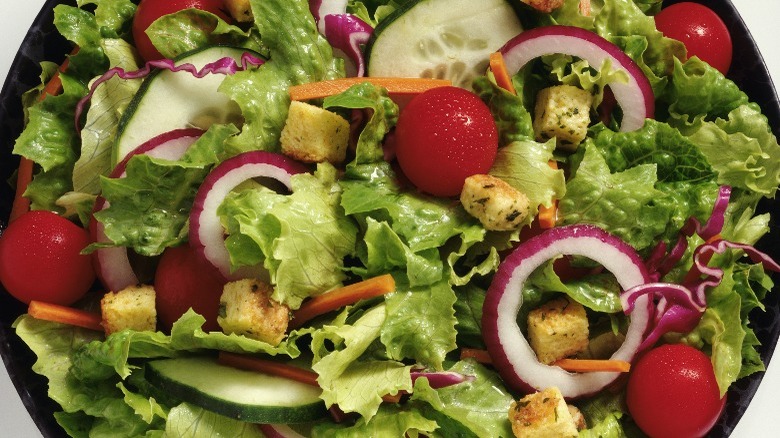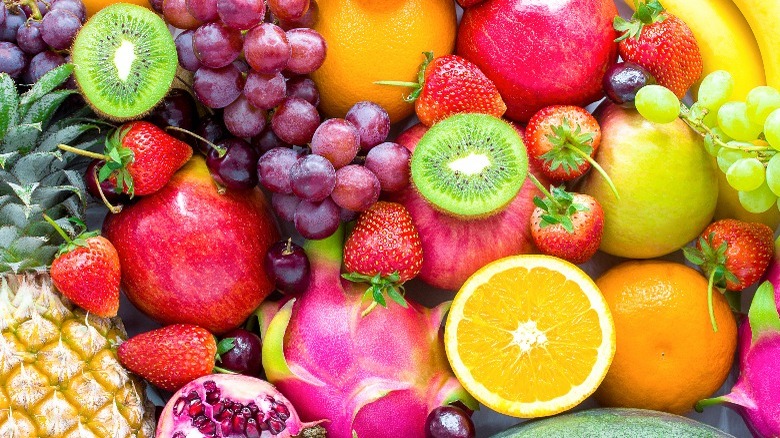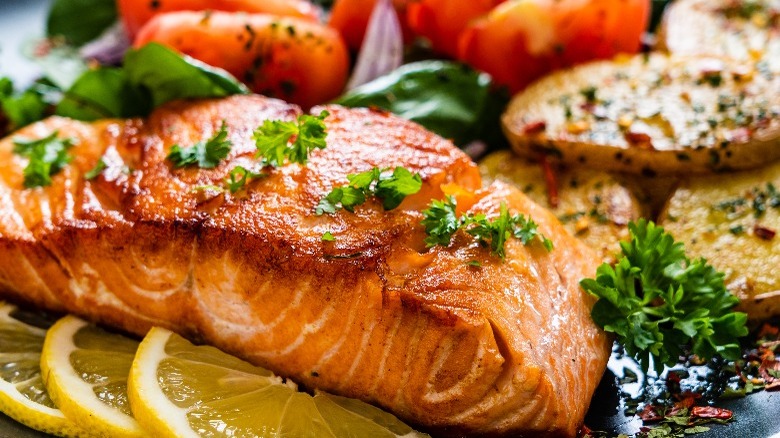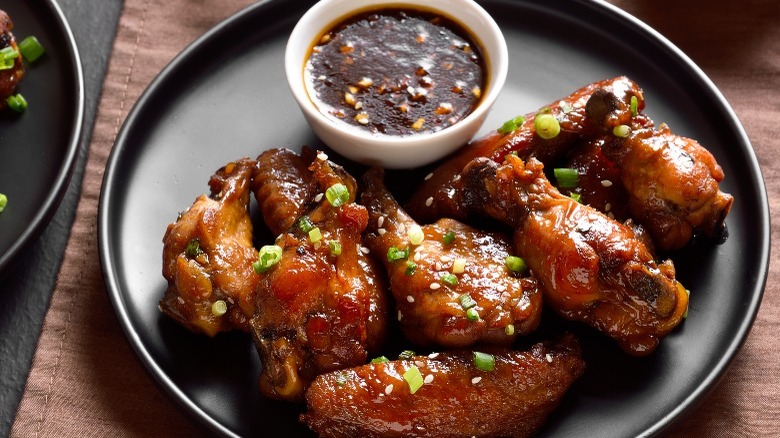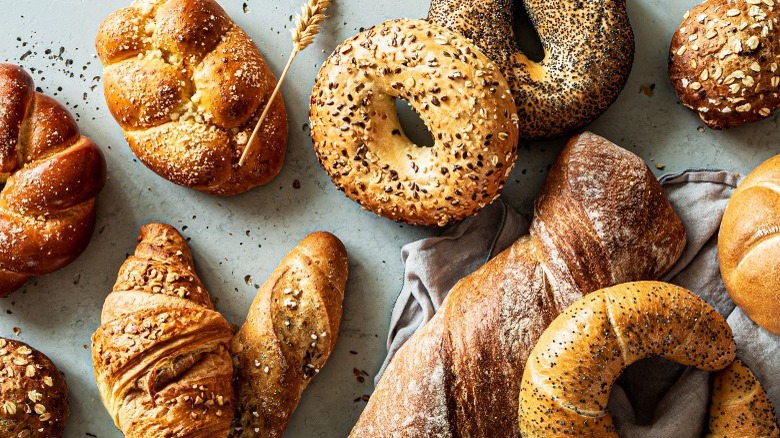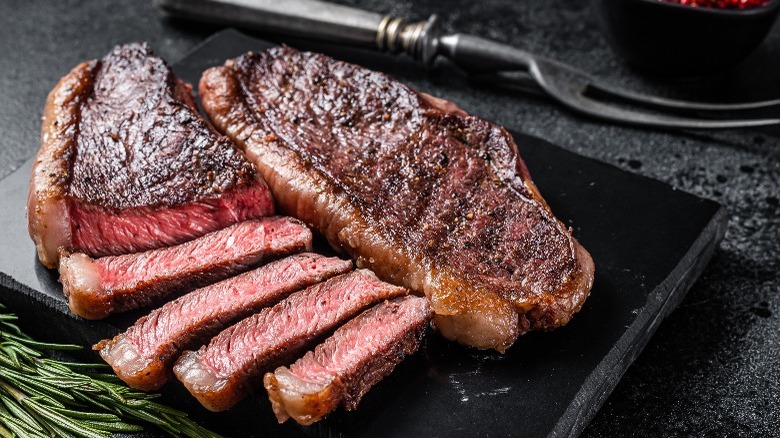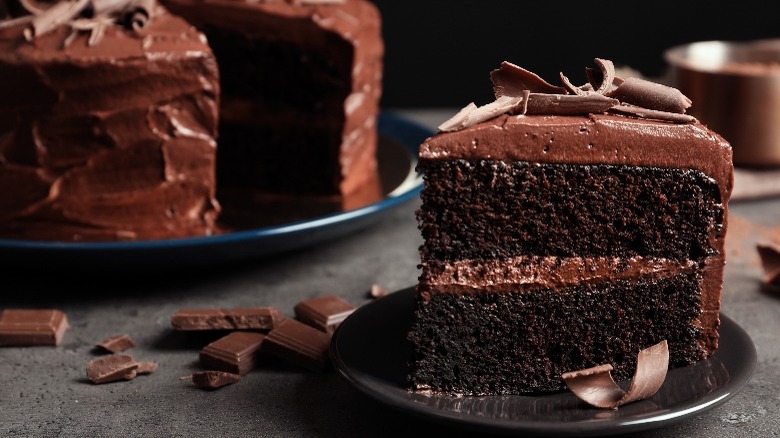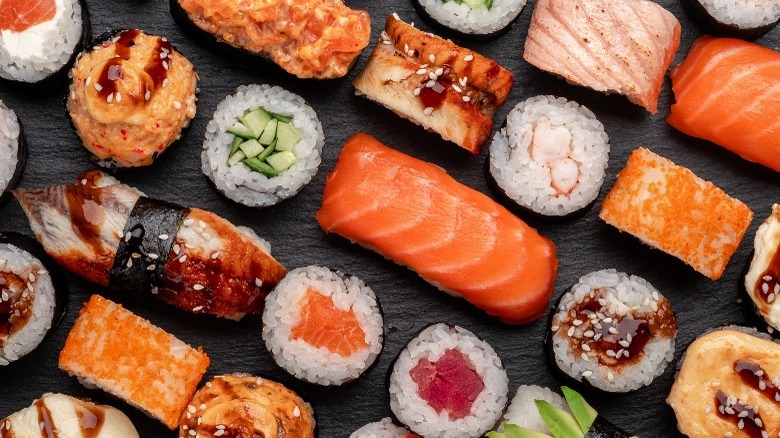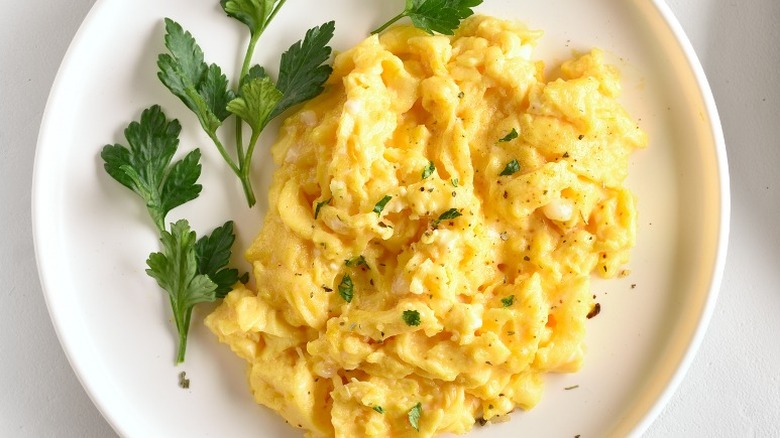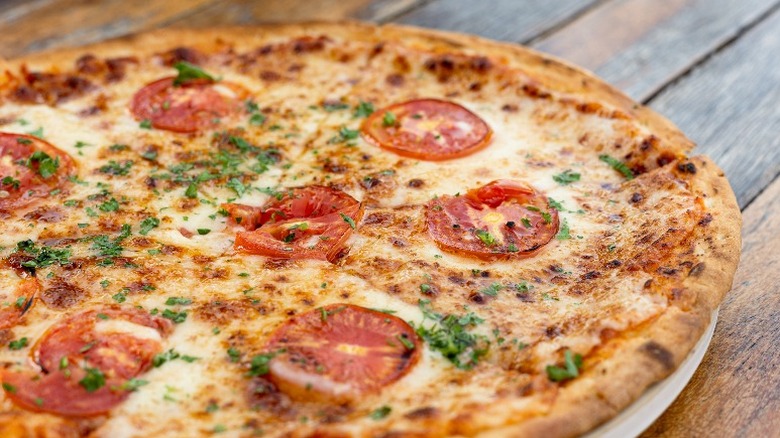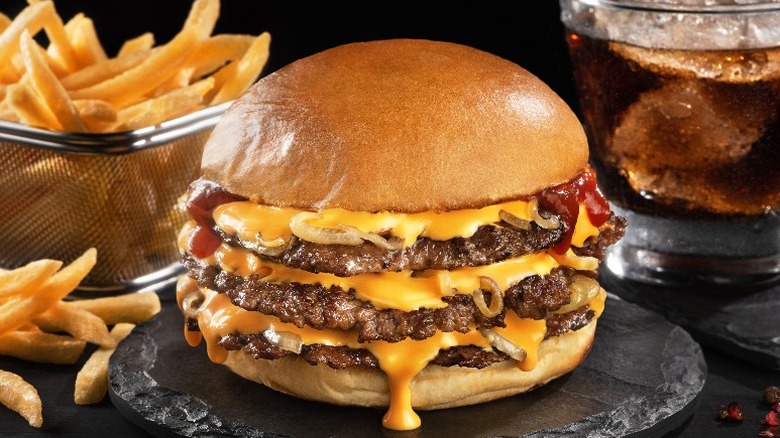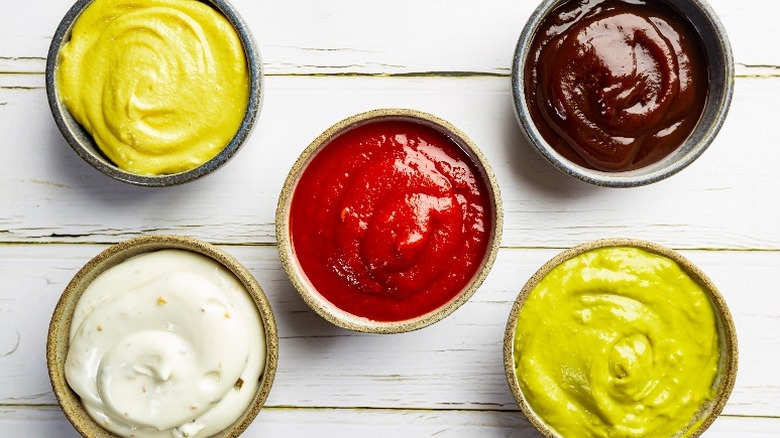13 Cruise Ship Foods You Should And Shouldn't Eat
Cruise ships are often essentially seaborne resorts that are known for providing plentiful food served in a variety of styles. There's a menu for every taste imaginable, from seafood to burgers to all-you-can-eat buffets. But not everything found in cruise ship dining rooms is ideal for the discerning diner. While some cruise ship food rises to the level of gourmet fare, other options wouldn't make the cut at a bottom-level fast food joint. Rather than taking your chances the next time you hop on board a seafaring behemoth with eats and treats to spare, it's best to be aware of what you're in for.
Though onboard dining and soft drinks are often included as part of cruise packages, ships also offer premier options at added cost. These options can expand your possibilities for freshly made food that may be tailored to suit your sensibilities. But even specialty meals has certain caveats. The good news is that no matter what your dining concession on the high seas may be, you can make informed choices to enjoy foods that are healthy and delicious while avoiding questionable dishes that might put a damper on your aquatic adventures.
1. Do Eat: Green salads
You can't go wrong with filling up on green salads on your cruise. Salad, in addition to being some of the freshest food on the ship, is also rich in filling in fiber content, which is beneficial to your health. Though salad bars allow you to build your own and control what goes into the bowl, salads prepared by the chef are usually fresher than salads presented as self-serve, which is something to consider when ordering.
As in any salad worth its weight in nutrition, certain greens make better choices than others. for example, iceberg lettuce may be plentiful but it contains more water and fewer nutrients than a richer green like spinach. If you have the option, try to order the richer greens if they are available. Topping a cruise-based salad can be tricky too, considering the incredible number of calories that salad accessories and dressing add to the plate. By ordering a green salad and requesting dressing on the side, you can control how much bedazzling your salad requires.
2. Do Eat: Fresh fruit
Fruit is always a healthy option, especially on a cruise ship. Choosing power fruits like berries and citrus will keep you hydrated and refreshed while also bolstering your immunity for any onboard contagion that you may contract during your trip. Fruit will satisfy your cravings leading to a more relaxed cruise experience. Because fruit is so portable, it's also a great option for taking back to your cabin for a later snack to prevent less optimal orders from room service when hunger strikes.
If you're looking for the safest and most delicious choices, it's best to opt for fresh fruit rather than less-healthy cut fruit served as pre-sliced pieces like pineapple and watermelon. This will allow you to minimize exposure to germs and lets you wash your fruit before eating it for added protection. Regardless of the form in which the fruit might appear at your table, you can gauge the temperature and edibility for yourself before taking a bite and choosing something fresher.
3. Do Eat: Cooked fish
As protein options on cruise ships go, cooked fish is not only theme-appropriate, but it's also one of the healthier dishes you can choose. Many cruise lines partner with local fishermen at cruise ports, allowing ship chefs to refresh their stock during the voyage. This means fish served on cruise ships may be fresher than beef or chicken, which has been frozen or refrigerated for untold hours by the time cruisers have a chance to dine. Since fish found in the self-serve buffet is often left under heat lamps and may be soaked in butter to keep it moist, fish prepared fresh by kitchen staff is always your best option.
Princess Cruise Lines takes the idea of fresh food to delicious extremes, allowing guests to catch and cook their own fish on certain excursions. This version of cruise-style dining adds to the adventure while letting you see where exactly your food comes from before ship staff cooks it for your dining pleasure. Imagine booking an onshore excursion to catch your own salmon or halibut, only to find it on your dinner plate hours later: Catch of the day, indeed!
4. Do Eat: Chicken
Chicken comes in many forms as part of a cruise ship menu. The healthiest options include baked and grilled chicken, preferably without skin to minimize calories and saturated fats. Options like fried chicken and chicken wings are often exposed to additional heat while waiting to be chosen at the buffet. Not only does the exposure toughen and dry the meat, it also allows exposure to environmental contaminants that aren't part of the recipe. Choosing fresh chicken options or having the chicken selection cooked to your preference will be your healthiest and most satisfying choice.
Frequent cruisers seemed to know the value of chicken on there seafaring adventures. As the largest cruise vessel in the world, Symphony of the Seas uses about 9,700 pounds of chicken per week. Guests can even find their favorite chain options onboard some ships. Cruise colossus carnival has introduced Shaq's Big Chicken on several of their cruisers to add familiarity to the lineup. With fast food-style chicken available, it may be tempting to dive in. Be sure to evaluate your choice in chicken for its health benefits as well as its flavor.
5. Do Eat: Bread
Though carbs have gotten the bad rap for years, bread is a mainstay for creatives guests to dine and snack on. Insider reports that, due to high demand, most ships will bake bread three times a day, ensuring that you have fresh loaves and rolls to enjoy. In fact, the number of bread rolls that can be used during a cruise is staggering. According to travel site Your Mileage May Vary, a ship may go through around 44,100 rolls. That's a lot of bread, no matter how you slice it.
Because bread is so often cast as the villain of the food world, consider the fact that you may be walking during many of your onshore excursions. Bread will provide you with the carbohydrates needed to create energy for your adventures. Moderation is key with almost everything you eat, which means as long as you don't go overboard with your bread consumption, enjoying bagels, buns, and bialys can add happy flavor to your sail through paradise.
6. Do Eat: Steak
If you're cruising in luxury, then you might as well dine in luxury too. Steak is one of the prime cruise ship food options, and not just for its high protein content. Many cruise ships offer premium steakhouses as part of the dining program. While these onboard restaurants may add extra to your vacation budget, they also allow you to choose your own cut of steak and customize your order. This is great news for particular eaters who like to exercise a little more control over how their food is prepared. In order to avoid food poisoning horror on the high seas, it may be best to err on the side of caution and order your steak closer to well done rather than rare.
Considering the hit-or-miss nature of some of the other so-called premium options, cruise ship steak may seem suspect. A discussion among Quora users largely confirms that the quality of steaks on a cruise ship is comparable to big-name steak chains. This should come as a relief to excited cruisers eager to enjoy a luxury meal to go with their incredible seaborne view.
7. Do Eat: Dessert
The reputation of cruise ships for providing decadent dessert selections is well-known. Many of these high-sugar extravaganzas take the form of all-you-can-eat chocolate lovers' buffets, which allows diners to go with their guts, and sometimes with their gluttony. While there's no denying the lack of nutritional value in a chocolate buffet, these foods are an undeniably enjoyable part of the cruising experience. Better yet, they are often freshly made on the ship by confectionary specialists who aim to please.
If indulgence is the order of the day, then a sumptuous selection of cruise ship desserts is bound to top your agenda. You may even find some well-known brands on your vessel to provide a familiar trove of treats. Travel Pulse notes that select luxury liners have begun including dessert favorites like Godiva chocolate and Ben and Jerry's ice cream among the cruise ship dessert offerings. Since shipboard desserts can sometimes look better than they taste, it may be beneficial to have brands like these you can trust when letting your sweet tooth take the lead.
8. Don't Eat: Sushi
If you wouldn't eat sushi from a gas station or an airport vending machine, then you probably shouldn't eat it on a cruise ship either. Raw food like sushi and sashimi that are presumably kept in controlled environments are the least trustworthy options on a cruise ship. Sushi pros will understand the need to keep raw fish at specific temperatures to ensure safety and preserve flavor. And if you're planning on eating sushi for the first time on your big adventure on the open seas, think twice. The resulting mess from bad cruise ship sushi will not only ruin your evening, but also ruin your entire trip.
Much of the risk comes from how sushi is stored in the ship's kitchen. Healthline states that storing sushi at room temperature for up to two hours is considered safe. But since you likely don't have a clear view of the kitchen, it may be difficult to trust that all measures have been taken to ensure food safety. Considering the incredible range of options on board, steering clear of the sushi in favor of more refreshing options is a safe rule to follow.
9. Don't Eat: Scrambled eggs
Cruise ship scrambled eggs will probably not top your best homemade scrambled eggs recipe; additionally, they may also be one of the least appetizing food items you eat during your vacation. Scrambled eggs are particularly fickle due to the preparation and the serving standpoints. Wet scrambled eggs stored in a warming tray can be a breeding ground for bacteria, while dry scrambled eggs that are kept under a heat lamp can become dry and leathery. Neither of these possibilities sounds the least bit delicious. Scrambled eggs can also come in the form of omelets, breakfast sandwiches, and egg cups, all of which come with the same possibility of culinary disappointment.
According to the CDC, eggs should be cooked to a temperature of 165 degrees Fahrenheit in order to be considered safe to eat. It can be difficult to tell if a cruise ship kitchen has undercooked scrambled eggs or if any liquid in the pan or on the plate may be a result of the preparation method. Either way, there's no reason to risk your entire cruise over a food item that you can easily replace with something less dicey.
10. Don't Eat: Ice cream cones
Ice cream dispensers can be very popular places on a cruise ship, which is precisely why they should be avoided at all costs. Self-serve ice cream can quickly lead to cross-contamination as everybody is required to touch both the dispenser handle and the cones. This touchy-feely scenario is the perfect set-up for the next unlucky guest to pick up germs from any of a number of previous users. And because ice cream cones require hand-held eating, diners will undoubtedly touch both the cone and their mouths as they enjoy their sweet treat.
Ice cream holds a sweet spot in the history of American treats, and it's a safe bet that cruisers will gravitate toward a self-serve station at some point during the journey. Even with hand sanitizer positioned nearby, there is no guarantee that all cruisers will follow proper hygiene. Additionally, grabbing your own cone sometimes results in accidentally touching the other cones. While it may be tempting to join the crowd and indulge, turn the ship around and head for safer harbor with a less contact-oriented dessert instead.
11. Don't Eat: Pizza
Pizza is a go-to cruise ship treat for practically any meal, especially for guests with small children who may be picky eaters. And while pizza always tastes better at a restaurant, cruise ship dining rooms can be a major exception to this rule. Pizza at a buffet will likely spend more than its fair share of time under a high-wattage heat lamp to keep it warm for diners. This little trick also serves to dry out every part of the pie, from the crust to the cheese to the sauce. The result is a pizza experience that falls flat. Your memories of enjoying cruise-based dining should be much happier than that.
It may be easy to think that freshly made pizza will be waiting at the buffet instead. While it's possible that the pizza is fresh, it's also likely that it has been sitting in a heated tray which will toughen the crust. Depending on the layout of the buffet, pizza is also a dish that many guests are likely to grab with their hands. This sort of cross-contamination can transform even the most delicious pizza into a top-notch stomach-turner.
12. Don't Eat: Hamburgers
Hamburgers served on cruise ships may top fast food hamburgers in terms of freshness and flavor, but they're still one of the least healthy options you can choose. Hamburgers can be quite heavy on the stomach and may add to the discomfort of anyone on a cruise ship who may have a sensitive stomach due to ocean motion. For people who may be seasick, indulging in heavy foods like hamburgers or cheeseburgers will add to their misery and may potentially result in hours spent in the sick bay or the cabin rather than enjoying the luxury vacation they paid for.
Lighter fare is a more favorable option, no matter how great the burger station may smell when you walk past. Hamburgers also pose a bacterial risk as they're a breeding ground if undercooked. Though some gourmet dishes on ship menus may feature raw beef, avoiding foodborne illnesses as serious as E. coli and salmonella means keeping your distance from hamburgers in any form.
13. Don't Eat: Condiments
Anyone with a refrigerator knows that ketchup, mustard, and mayonnaise are all "refrigerate after opening" foods that shouldn't find permanent residence on a countertop. Refrigerating condiments is key for keeping them fresh and edible. Condiments on cruise ships are often left on tables or at serving stations for longer than ideal, creating a perfect storm of moisture and warmth needed for bacteria growth. If this bacterial growth reaches high levels, it can cause food poisoning that's sure to cast a rain cloud over your cruise excitement.
Many times, cruise ship condiments are not found in bottles but are available in smaller serving dishes that are shared by tables of diners. This adds an extra twist of cross-contamination by being exposed to airborne germs. Tables filled with excited cruisers sharing stories about their adventures will undoubtedly be adding their own contributions to the condiment Petri dishes. Consider leaving the spreads and sauces off your food altogether. If you absolutely must have ketchup, mustard, or mayonnaise, ask your waiter or the buffet attendants if fast food-style foil packets are available instead.
